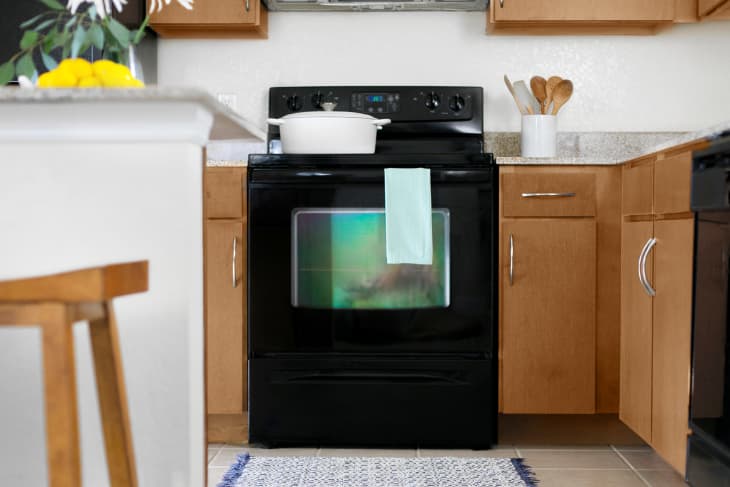How To Clean Wood Kitchen Cabinets (and the Best Cleaner for the Job)
Spot-cleaning kitchen cabinets after spills and drips is easy enough, but finding a process and product that removes the grime and grease from many a meal preparation takes patience and a little bit of label research (especially if you are tackling a painted surface).
I tested four cabinet cleaners — two spray formulas, a plant-based product, and a traditional oil soap — to find out which product would clean my kitchen cabinets best. Here’s what I discovered, and how you can clean greasy cabinets at home.
Reorganizing my kitchen storage has improved function and cut dishwasher unloading time by at least a third. While the renewed pleasure of our space is exciting, my number-one kitchen complaint was still the state of the cabinets. I periodically handle surface stains and drips with a quick spray and wipe, but unfortunately my routine with a multi-surface cleaner was no longer doing the trick. Grime, grease, and spills were still hanging around after each cleaning.
Daydreaming about painting them for three months didn’t get me very far, so I came down from the clouds and tested a few methods and products for reviving kitchen cabinets.
The Results of the Four Cleaners I Tested
1. Bona Cabinet Cleaner, $9 for 36 ounces
The popular hardwood floor cleaner company, Bona, makes a specific cabinet-cleaning product. I was eager to try it after reading great reviews of their floor care system and cleaner. The spray-bottle formula was too drippy for my liking, but had almost no scent (a win in my book!) and worked well on crevice and surface stains. Unfortunately, there was an apparent sticky residue on cabinet surfaces after using this product.
Verdict: Not my favorite.
2. Magic Cabinet & Wood Cleaner, $6 for 14 ounces
Unfamiliar with this brand, I was delighted to discover it was appropriate for painted cabinet surfaces as well. (You know, in case I ever get to painting my cabinets.) The spray-bottle formula (there’s also an aerosol) had a wider, even spray, but smelled the most cleaner-like to me. The thicker spray made it great for crevices and it offered a smoother finish after wiping than the other spray products.
Verdict: A solid performer.
3. Method All-Purpose Spray, $11 for two, 28-ounce bottles
Method is my favorite brand of multi-purpose spray cleaner. I use it daily for countertops. Their multi-purpose product for grease and grime stays true to their product formulas with naturally derived, biodegradable ingredients — and the citrus smell was surprisingly delightful. If you are a Method product fan, try this product, but let it sit a few minutes and prepare to scrub a little harder for stain removal.
Verdict: Works well if you let it sit and really scrub.
4. Murphy’s Oil Soap, $18 for three, 32-ounce bottles
Tried-and-true Murphy’s Oil soap has been around for more than 100 years, and it won my overall vote. It cut through the grime and grease with more ease than the other products and left a beautiful, silky finish on cabinet surfaces. The citrus scent is also mild and doesn’t linger.
Note: Do be mindful of which formula you choose if you have painted cabinets. For the concentrated formula, you’ll have the added step of diluting and applying with a cloth.
Verdict: The best cleaner of the four!
How To Clean Wood Kitchen Cabinets
What You’ll Need
- Cleaner of choice
- Toothbrush or small scrub brush
- Bowl
- Clean, dry cloth
Instructions
- Pick your cleaner: If you didn’t read my official product test, go back and give it a read before you view these steps. I found that Murphy’s Oil Soap cleaned best overall for a silky, reconditioned surface, so that’s what I’m using here.
- Ready your mixture: To spot-treat stains from drips and spills, dilute oil soap in a bowl of warm water. Wet a toothbrush or small scrub brush by dunking it into the bowl and repeat as needed.
- Scrub hardware: Scrub around the hardware edges on your cabinets.
- Scrub the hard-to-reach places: Use the brush to get into the nooks and crannies — especially the details of your cabinet faces. Removing buildup might be a more involved step if your cabinet facing is more intricate.
- Clean cabinet surfaces: Using your cleaner of choice, spray or wipe cabinet fronts one at a time. Wipe each one down with your cloth.
- Get the insides, too: Don’t forget to address the sides of each drawer and door while you’re wiping.
- Repeat as needed: Repeat as necessary until all grease spots and fingerprints are gone!
